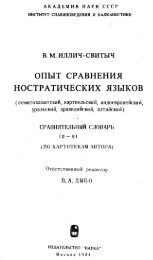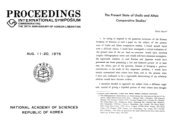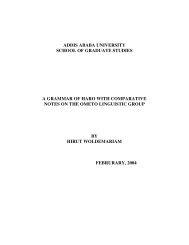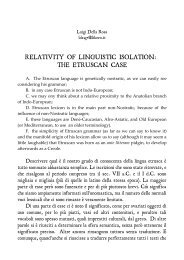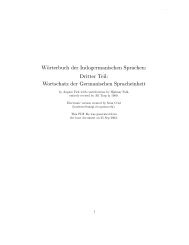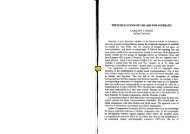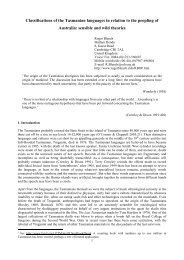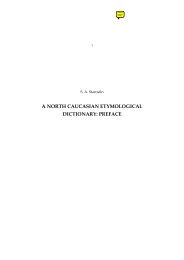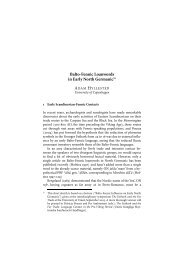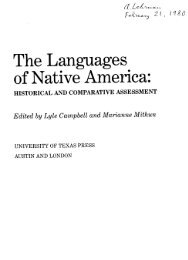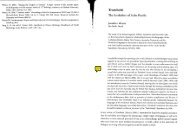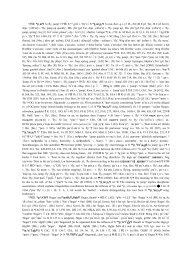The Indo-European Elements in Hurrian
The Indo-European Elements in Hurrian
The Indo-European Elements in Hurrian
Create successful ePaper yourself
Turn your PDF publications into a flip-book with our unique Google optimized e-Paper software.
<strong>Hurrian</strong> Verb Morphology<br />
6<br />
Verbal Morphology<br />
<strong>Hurrian</strong> verb morphology is extremely complicated. As <strong>in</strong> nom<strong>in</strong>al forms, the root comes<br />
first, but, unlike the noun, it is not followed by a stem vowel (“thematic vowel”). <strong>The</strong> root is<br />
followed by derivational suffixes, followed by aspectual/temporal forms, followed by valency<br />
markers (class markers), negative markers, and person and mood markers. <strong>Hurrian</strong> verbs clearly<br />
dist<strong>in</strong>guish transitive and <strong>in</strong>transitive (cf. Bush 1964:177—178). Though most verbs are either<br />
exclusively transitive or <strong>in</strong>transitive, some can be used as both, for example: un- ‘(<strong>in</strong>tr.) to<br />
come; (tr.) to br<strong>in</strong>g’; na¯¯- ‘(<strong>in</strong>tr.) to sit down; (tr.) to set, to put, to place’; an- ‘(<strong>in</strong>tr.) to be<br />
pleased; (tr.) to please’. 84 <strong>The</strong> end<strong>in</strong>gs of transitive verbs agree with the person and number of<br />
their subject, but this is not the case with <strong>in</strong>transitive verbs. <strong>The</strong> direct object and the subject of<br />
<strong>in</strong>transitive verbs, when they are not represented by an <strong>in</strong>dependent noun, are <strong>in</strong>dicated by clitics<br />
and pronouns.<br />
One of the notable characteristics of <strong>Hurrian</strong> verb morphology is “valency”. Valency<br />
refers to the number of noun phrases governed by the verb. <strong>The</strong> valency of a verb can be<br />
modified either by chang<strong>in</strong>g the valency marker or by us<strong>in</strong>g a suffix that <strong>in</strong>dicates <strong>in</strong>transitive.<br />
Accord<strong>in</strong>g to Speiser (1941:85), <strong>Hurrian</strong> dist<strong>in</strong>guished between three valency markers (Wilhelm<br />
and Bush call them “class markers”; Diakonoff [1957:5], on the other hand, calls them<br />
“<strong>in</strong>dicators of transitiveness and <strong>in</strong>transitiveness”):<br />
(1) -a-: one valency, <strong>in</strong>transitive, apparently only with verbs of motion;<br />
(2) -i-: two valencies, transitive used <strong>in</strong> the active voice; and<br />
(3) -u-: two valencies, transitive used <strong>in</strong> the passive voice. 85<br />
<strong>Hurrian</strong> person names can exemplify this system. <strong>The</strong> valency marker is followed by the<br />
(obsolescent) <strong>Hurrian</strong> pronoun *-b represent<strong>in</strong>g ‘P3 sg. + past tense’, 86 often written with ,<br />
or the more recent -š. <strong>The</strong> three valency markers function as follows:<br />
- Unab-šenni ‘a brother came’ (<strong>in</strong>transitive)<br />
- Tadu-Àeba (fem.) ‘Àebat is loved’ (transitive <strong>in</strong> the passive voice)<br />
84 Examples from Wilhelm (2004a :110).<br />
85 Wilhelm’s (2004a:111) approach does not seem to fit the pattern of person names.<br />
86 It can be noted that -b seems to be miss<strong>in</strong>g, especially <strong>in</strong> fem<strong>in</strong><strong>in</strong>e person names. Speiser (1941:139) nevertheless<br />
rejects the idea that this may have a connection with grammatical gender.



